The idea of bolting a bed to the back of a Jeep isn’t new – it was done decades ago – but it’s nice that Jeep remembered it!
And improved upon it.
This Jeep-with-a-bed has four doors instead of just two – as Jeeps with beds had in decades past. And now you can get it with a rumbly diesel engine, too.
Or, stick with the standard gas V6 – and the stick.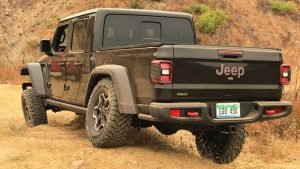
Which you can do because this Jeep is just about the only new truck you can get that comes standard with a manual transmission.
With the V6.
What It Is
The Gladiator is a four-door Jeep Wrangler with a pick-up bed behind it that’s meant to both compete with and offer an alternative to mid-sized trucks like the Chevy Colorado/GMC Canyon twins, the Nissan Frontier, Ford Ranger and Toyota Tacoma.
Some of them offer a V6; the Gladiator comes standard with it. One of them offers a diesel engine – but it’s not a V6 and you have to buy the most expensive trim before you can buy it.
Jeep offers a diesel V6 option with all Gladiator trims.
Which otherwise all come standard with a manual transmission – and a big V6 instead of little four, as is standard in most of the rest, which are also mostly automatic-only.
And none of which offer things like doors you can unbolt and a roof that comes off, which the Gladiator also comes standard with.
The price you pay for all that is a higher price to start – $35,245 for the base Willys trim all the way up to $51,500 for a top-of-the-line High Altitude trim.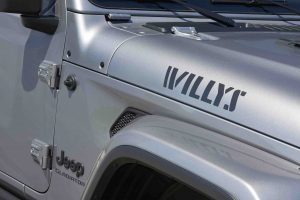
But this is a case of getting what you paid for – including things you can’t get elsewhere,no matter how much you pay for them.
What’s New
The big news for ’21 is the availability of a mighty (442 ft.-lbs. of torque) turbodiesel V6 engine option – which is actually a diesel package that includes a 3.73 axle ratio, locking differential, dual batteries and 245/75-17 all-terrain tires.
What’s Good
An alternative to a truck that does more than most trucks can do.
Gratifyingly hands-on and mechanical. Manual crank windows are available; 4WD is engaged by pulling a shift handle, not by pushing a button.
More than one engine – and transmission – option.
What’s Not So Good
It’s expensive relative to trucks about the same size like the Ford Ranger ($24,820 to start), Chevy Colorado ($25,200) and Toyota Tacoma ($26,150).
It’s only available with a crew cab – and a short (five foot) bed.
Interior needs more places to put – and secure – small items.
The Gladiator costs more than the mid-size pick-ups it kinda-sorta competes with for buyers – but Jeep gives you more for your money, including a standard 3.6 liter, 285 horsepower V6 for openers.
Pick-ups like the Chevy Colorado and its GMC-badged twin the Canyon come standard with a 2.5 liter, 200 horsepower four cylinder engine.
The Ford Ranger comes only with a four cylinder engine – though it is turbocharged to 270 horsepower. But it is paired only with an automatic transmission. Ditto the automatic-only Colorado/Canyon. The Gladiator’s V6 gives you the option to buy one if you like but comes paired with a six-speed manual transmission as standard.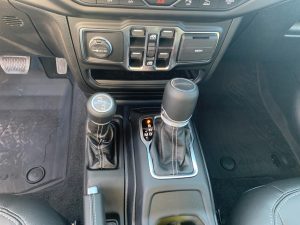
The Toyota Tacoma offers a manual paired with a V6 – but only in the TRD trim, which stickers for $34,835 – making it slightly more pricey than the base trim Gladiator
What none of the above offer is a diesel engine option in any trim — or even at all.
The Tacoma and Ranger and Frontier are gas-engine only. The GM pick-ups are available with a diesel engine but the option is restricted to high-trim crew cab models and it’s only a four cylinder (2.8 liter) turbodiesel that makes just 181 horsepower and 369 ft.-lbs. of torque.
The Jeep’s across-the-board available 3.0 liter turbodiesel V6 makes 260 horsepower and a mountainous 442 ft.-lbs. of torque. It’s also not just a diesel V6. Jeep bundles this engine with a more grunty 3.73 axle ratio, an upgraded brake package, dual battery system, supplemental heater and a set of all-terrain tires on 17 inch wheels.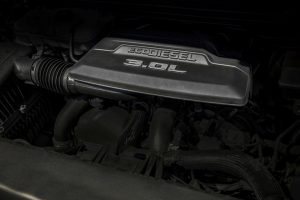
The catch is you also have to buy the mandatory-with-this-engine eight-speed automatic, which adds another $2,000 to the tab.
Weirdly, the diesel is rated to tow less than the gas V6, which maxes out at 7,650 lbs. vs. 6,500 for the diesel-powered Gladiator. Apparently, this isn’t because the diesel’s weaker but rather because the iconic Jeep barred grille doesn’t allow for sufficient airflow to keep the hunky diesel cool enough to pull as much weight as the gas V6 is rated to pull.
But the diesel doesn’t have to work as hard to pull a load.
Its peak torque output is available at 1,400 RPM and maximum horsepower – which is almost as much as the gas V6 makes – comes online at 3,600 RPM vs. 6,400 RPM for the 3.6 liter engine.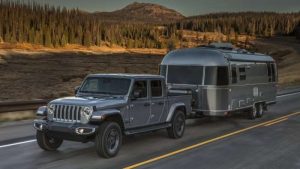
There’s also the compensation of range – a function of the diesel’s better mileage. A diesel-powered Gladiator goes about 6 miles farther per gallon (22 city, 28 highway) than the gas-powered version (17 city, 22 highway with the optional automatic; 16 city, 23 highway with the standard manual) which works out to about 532 miles of highway driving for the diesel vs. about 440 for the gasser.
And in an End Times scenario, the diesel has the advantage of being capable of burning home-brew whereas you need a refinery to make gasoline.
All Gladiators come standard with part-time/selectable four-wheel-drive and a two-speed transfer case with 4WD Low range gearing.
4WD is optional in all of the Jeep’s mid-sized truck competition.
The Gladiator – like the “mid-sized” pick-ups it nominally competes with – is closer to being full-sized, if compared with the size of historically full-size trucks from before the early 2000s, when “full-size” trucks were super-sized.
It is 218 inches long, which for the record is half a foot longer than a 1990 Chevy Silverado 1500 regular cab (212.6 inches) but much less-long than a 2021 Silverado regular cab, which is 231.7 inches long.
Most of the Gladiator’s length is its cab, which is crew – four full-sized doors – counterbalanced by its short (five foot) bed, without which it would be Wrangler-sized.
Actually, it would be a Wrangler.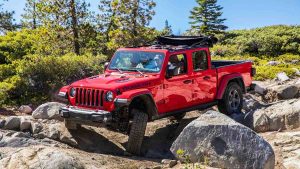
But it’s the width that modulates the length of this thing. It is only 73.8 inches through the hips, which is – no kidding – about half a foot less wide than a current full-size 4×4 pickup like the Ford F-150 FX4 I reviewed a couple of weeks ago.
This makes it feel not-too-big on the road and gives it a big advantage off-road, which is the Gladiator’s natural second environment. It can pass in between trees on the side of trails that would stymie a 1500-sized 4×4 – and it can crab by another vehicle coming down the narrow dirt or gravel road with no shoulder on either side that you’re trying to go up.
It is also something else that none of the mid-sized pick-ups it nominally competes with are – which is mechanical and hands-on, from its standard roll-up windows to its manually-engaging 4WD – which engages the ranges positively rather than electronically. This way of engaging the ranges is also probably more durable over the decades than anything electronic. Electrical contacts and switches wear over time; connections corrode. Sensors stop sensing – and then what? The Gladiator’s 4WD shifter will never suffer such a failure and even if it does fail, it’ll be mechanically and you can still gerry-rig rods and cables in a pinch.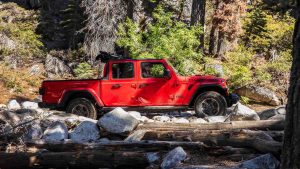
The option to shift gears mechanically is another tactile plus. It gives you, the driver, more control over the drive because you control the shifts. Modern automatics are also electronic things – their shifting controlled by their programming. This if ok, if you don’t mind not having the same degree of control. But if you want total control over your shifts, the Jeep’s the thing.
Plus, it’s fun.
This time around, I got to test drive the Gladiator with its new turbo-diesel V6 and the most impressive thing about it to me wasn’t how much it tows but how much it hauls.
When you stomp on the gas, it moves. Zero to 60 in just over 7 seconds – which in a 4,672 lb. 4×4 with a diesel engine is impressive.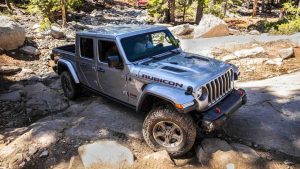
For comparison: A Chevy Colorado diesel needs more than 9 seconds to heave itself to 60, on par with the slowest gas-engined economy cars on the road.
The Jeep’s speed is the result of having both torque and horsepower – almost as much of the latter (260) as the gas V6 makes (285). The usual diesel disparity between horsepower and torque – as in the case of the Chevy Colorado diesel’s 180 hp and 369 ft.-lbs. of torque – doesn’t exist here. You get both horsepower and torque in abundance and because of that, the diesel-powered Gladiator is both Clydesdale-like on the low end, as you’d expect from a diesel – and not breathless once you’re rolling.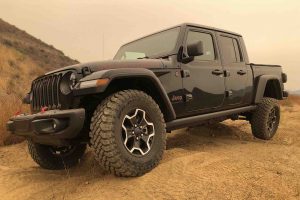
Punch it at 55 to pass a slowpoke and the thing passes.
And it will also go almost anywhere, since it can crawl over almost anything. Especially Rubicon versions, which come with a Rock-Trac transfer case with 4.0:1 low range gearing (2.72:1 is standard in other trims) front and rear locking diffs, a disconnecting front sway bar (to allow greater individual articulation of the front wheels) removable front and rear bodywork and 33-inch off-road knobby tires.
At The Curb
Other brands have been trying really hard to recover their identities by reaching into the past and incorporating bits and pieces of it into their current models.
Jeep hasn’t had to do that because it never forgot its past.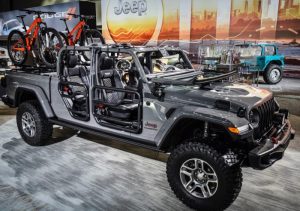
The Gladiator is a new Jeep, obviously – but it’s also obviously a Jeep and so not like anything else. It is the only rig you can buy new that has a hood you open from outside – by unclamping it. A roof that unbolts.
Doors, too.
It is modern, of course – and so offers such things as an LCD touchscreen with interesting apps such as Off Road Pages that display the vehicle’s pitch and roll as you go – but it is also charmingly familiar to anyone who drove a Jeep 40 years ago and loved it. The upright breadbox dash. The upright windshield. The very deliberate absence of a button to engage the 4WD. Power windows – if you want them – that open and close exactly as far as you want them to – as opposed to the usual peremptory all the way up and all the way down and good luck trying to stop them where you want them to.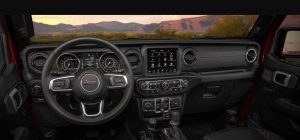
All versions have 11.1 inches of ground clearance and can ford 30 inches of water – but you can climb aboard without a ladder and once you’re in, the view is spectacular. Not because you’re jacked up off the ground but because of all the vertical glass. Your are inside a metal box with windows all around, not an inward-curving canopy that slopes to the rear, tunnel-visioning your view of the rear.
The Jeep has a first-rate back-up camera – but you need it like Trump needs another cheeseburger.
You also have equal headroom – 42.8 inches front and rear – because of the box it comes in. The second row has 38.3 inches of legroom, too – and so comfortably carries adult-sized passengers while the five foot bed carries your dog or a pair of dirt bikes. Its bedwalls are not Everest-high, either – so you don’t need a stepladder to get at what you put in it.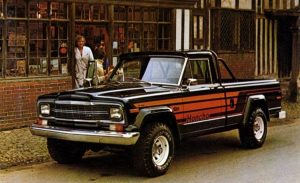
The one thing the Gladiator doesn’t offer is the option to skip the extra doors – and swap them out for a longer bed. Jeep used to sell a model like that – it was called the Comanche (last sold new back in ’92). The original Gladiator (last sold new back in ’88) was also a two-door truck with a longer bed.
But such trucks aren’t as popular today because most people who buy trucks today need the extra passenger-carrying capacity and – apparently – don’t need a six or eight-foot bed.
The Rest
If you like Jeeps it is hard to find anything not to like about this Jeep.
It could use more interior storage space.
There’s webbing on the lower door panels, no molded-in place to toss your loose change and such.
And Jeep had to add the obnoxious engine stop/start system (ASS) that shuts the engine off at every red light, then stutter-starts it back to life when the light changes – to “save gas” but really to comply with federal stupidities. All car manufacturers have had to add ASS – because of the need to placate federal stupidities.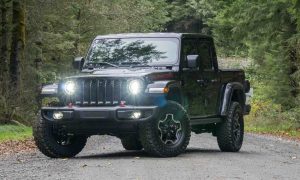
But ASS is easily (and legally) defeated if you prefer to leave your engine running until you decide to shut it off.
The Bottom Line
It’s nice that Jeep remembered not to forget!
. . . .
Got a question about cars, Libertarian politics – or anything else? Click on the “ask Eric” link and send ’em in!
If you like what you’ve found here please consider supporting EPautos.
We depend on you to keep the wheels turning!
Our donate button is here.
If you prefer not to use PayPal, our mailing address is:
EPautos
721 Hummingbird Lane SE
Copper Hill, VA 24079
PS: Get an EPautos magnet or sticker or coaster in return for a $20 or more one-time donation or a $10 or more monthly recurring donation. (Please be sure to tell us you want a magnet or sticker or coaster – and also, provide an address, so we know where to mail the thing!)
My eBook about car buying (new and used) is also available for your favorite price – free! Click here. If that fails, email me at [email protected] and I will send you a copy directly!


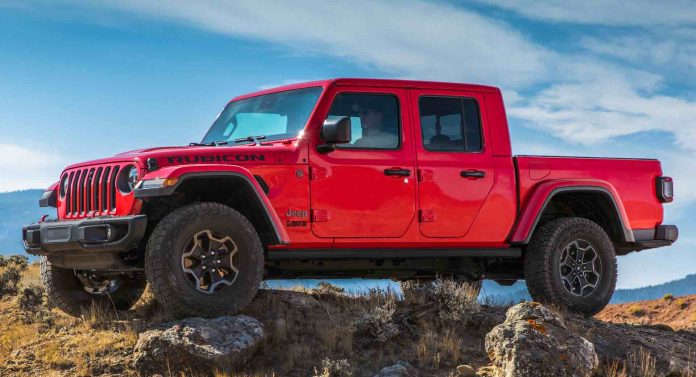

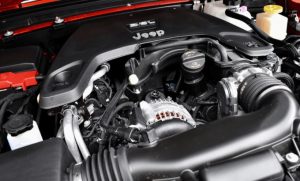
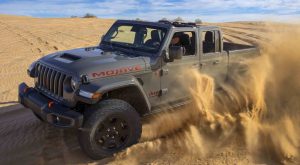







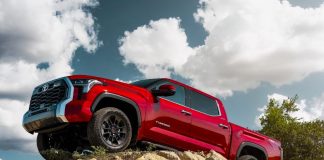
Good luck finding one that is close to the base model. Just built one that i thought was reasonable at 37500 but searching inventory near me the cheapest one was over 41000.
I’ve had my Gladiator since October 2019, and have zero complaints (except the auto park feature when you open the door-that is 2 degrees past ignorant)
Honestly, it’s the last hope for a new truck with any degree of actual utility. It’s not excessively huge like the current full-size trucks, and not as fragile as the IFS creations. Goes anywhere comfortably, and allows the joy of actual driving, rather than button pushing.
Hopefully Jeep keeps up the fight!
Hi El Guapo!
I like it also; and thanks for mentioning the auto park function. BMWs have this also. It is, as you say, “past ignorant.”
At the top end price point, save the manual 4×4 engagement, I’d take a full size truck (used).
While mildly practical with the bed, it just strikes me as a project vehicle.
Vs other mid sizes, it is worth a look.
My friend is due for a new car around his birthday in Nov, and being he’s a Diesel freak, steering him away from used Eurotrash crossover’s and towards a Gladiator here, as I always remind him how he’s at the beach constantly and also on the prowl, two things that lean itself towards a soft top without the doors on.
This was my 2nd choice Truck wise until I had to get my Ram, but they’re definitely solid, although personally a 3.6 w/a stick would be ideal vs a Dizzle with the $6k+ Premium (D only makes sense after depreciation and assuming you travel far daily)
It reminds me of the U.S. Army M151A2, a four-cylinder gas-engine 4×4, which I drove forty years ago. Nothing was more functional for its purpose.
I think it’s an interesting vehicle, even with the Harley Davidson-like “don’t screw with my nostalgia” feel. Let’s hope they can keep making them for a very long time. Personally I’d like to see a Comanche based on the Grand Cherokee instead of this, but I’m already seeing them around town.
Jeep did a Renegade based Comanche concept for Easter Jeep Safari a few years back.
Other than Wrangler/Gladiator and the upcoming Wagoneer, the rest of the lineup are crossover based, and only the JL/JT can get a traditional 4×4 system.
If the Ford Maverick actually happens and succeeds, maybe Jeep will look at a new Comanche.
‘Gratifyingly hands-on and mechanical. Manual crank windows are available; 4WD is engaged by pulling a shift handle’ — EP
All admirable; all exactly whut I like in a truck. But … *clears throat portentously*
We all know that Jeep is still riffing off the 1940 design of the original Jeep MB. But after 80 years, the ‘spartan chic’ of exposed-hinge brutalism is getting rather old.
Feast your eyes on the flat side windows and square-block rear cab corner. That’s how old-timey, black-rattletrap sedans were shaped during the Coolidge administration, when technological constraints such as flat glass banished thoughts of curves and streamlining. Today the applicable term is ‘anachronistic.’
But all that soon changed. The peoples car, Volkswagen, nicely integrated vestigial pontoon fenders and a streamlined body, way back in the mid-1930s. That’s one reason it was produced for 60 years with only modest tweaks.
Jeep’s uncouth farm implement look comes across as genuine in an actual vintage design like the Roxor, which doesn’t pretend to be anything else. But in a new vehicle that starts at $35,000-plus, the boxy Massey-Ferguson angled tractor fenders on slab-sided bodywork hint at self-parody, though many buyers may not be in on the joke.
The first MB Jeeps weighed 1,300 lbs; this behemoth packs nigh on 4,700 lbs. Kind of like having a 90-lb sprite of a girl — ‘built for speed with the tools you need,’ as ol’ Billy Joe Shaver used to say — pooch out to a scale-busting 325 lbs when you weren’t looking. Sad!
Hi Jim,
Yes, but it’s not a pretender. 442 ft.-lbs. of torque! Serious 4WD. I like the slab-sided, stamped steel (actually aluminum now) bodywork. It is functional – which makes it look good to me.
I bet you’d change your mind if you drove one! 🙂